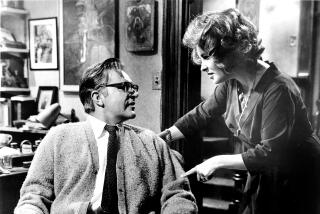Vita Longa, Harold Brevis : VITA AND HAROLD: The Letters of Vita Sackville-West and Harold Nicolson, <i> Edited by Nigel Nicolson (Putnam: $29.95; 452 pp.)</i>
- Share via
They had a smallish country wedding. After five years of what appeared to be fairly humdrum domesticity, during which sons Nigel and Ben were born, they decided to go their separate ways--sexually. She was bisexual, though leaning more in the lesbian direction. He was gay. But in the wake of an emotional upheaval caused by an affair of hers, they were convinced that their love for one another was so strong that their marriage would not be threatened by their extramarital “muddles.”
They might have met during the Summer of Free Love in San Francisco and honeymooned at Woodstock. In fact, Vita Sackville-West and Harold Nicolson met at a society dinner party in London in 1910 when she was 18 and he was 24.
It is generally easier to approach a collection of letters, or diaries, having read a biography or the works of a subject first. While “Vita and Harold: The Letters of Vita Sackville-West and Harold Nicolson” is engaging to read, some knowledge about the literary couple and their circle will dramatically increase a reader’s enjoyment. Editor Nigel Nicolson has provided ample biographical information in the introduction and commentary to satisfy even the most curious, and “The Letters” provides a good steppingstone to the fascinating diary/biography, “Portrait of a Marriage” by Nigel Nicolson. Masterpiece Theater’s three-part miniseries based on that book may be the primary introduction many Americans have to Vita Sackville-West and Harold Nicolson, who are quite celebrated in their native England. (The magnificent actress Janet McTeer, who portrayed Vita, has captured the humorlessness, intensity and physical grandeur that she apparently possessed. And Harold--on television and in his letters--comes across as mild, loving, maternal, patient beyond the call of duty, and always well dressed, even while gardening.)
Sackville-West wrote novels and poetry very popular in their day, and one impressive travel book, “Passenger to Teheran.” But she is best known for her elegant, informative gardening columns written for the Observer in the 1940s and ‘50s, and, along with her husband, for the creation of the hauntingly beautiful gardens at Sissinghurst Castle in Kent.
Nicolson was a diplomat who turned journalist, politician and biographer. (His official biography of King George V led to knighthood. Harold was humiliated: “Niggs (son Nigel) . . . being a sensible lad he quite saw that it would not be possible for me to refuse without appearing churlish, snobbish and conceited. But how much more I would have liked a Regency Clock.”) He and Vita were expecting a peerage, something much more along their lines. They were incredible snobs when it came to things like lineage, wealth and titles. Vita and Harold--nicknamed Mar and Hadji respectively--even had a private word for anything common --”bedint.”
If anyone had reason to be snotty about lineage, wealth and titles, it was Vita, the only child of Lord and Lady Sackville. The Sackvilles had been hobnobbing with the crowned heads of England since Elizabeth I awarded them Knole, a Gothic manor house built in the late 15th Century. She grew up a lonely, eccentric child amid 365 rooms full of grand portraits of titled ancestors, a house that was part of England’s history itself--from the era of Henry VIII through Cromwell down to the Battle of Britain, when part of it was bombed.
Virginia Woolf, Vita’s most famous lover, was much taken by the majesty of Knole; “Orlando,” is as much a paean to the manor house as it is to Vita. Vita’s loss of Knole due to primogeniture--her uncle, then male cousin, inherited the title and house--haunted her all her life; in truth, she would as soon never have set foot outside the gates of its vast deer park.
Harold, the son of Lord Carnock, followed his father into the diplomatic service. He participated in the peace conference in Paris following World War I, working side by side with, among others, Prime Minister Lloyd George, President Wilson and Clemenceau of France. Vita, who had lived briefly with him at Constantinople when they were first married, hated the expatriate life of diplomatic wives and chose to remain back home, first at Long Barn (the old farmhouse they called “the mud pie”) and later at Sissinghurst Castle, where she worked in the garden, wrote her poetry and fiction, and carried on several affairs.
Harold, off in foreign capitals, referred subtly in his letters to various “friends” he met along the way. He told Vita about one special new acquaintence in Paris, a dressmaker he thought he might move in with. But Harold never entertained notions of leaving Vita and the boys. His dalliances were momentary amusements and had nothing at all to do with his beloved family life.
For Vita, it was not that simple.
In 1918, Vita fell into a passionate affair with Violet Keppel, a friend from school. She left her children--aged 2 and 5--at home while she and Violet went off to Cornwall and France for months on end. During the course of the liaison, Violet married Denys Trefusis. After the marriage, Vita and Violet decided to leave their husbands and elope to France.
Vita recorded every detail of this three-year-long affair in the diary that was later incorporated into “Portrait of a Marriage.” The elopement almost destroyed the marriage, but the love between Harold and Vita won out over her obsession with Violet. She returned to Harold and home in 1921. Other romantic relationships followed--with writer Geoffrey Scott, Virginia Woolf, Mary Campbell--but none of these threatened the marriage.
“I think it was partly your fault, Hadji. You were older than me, and far better informed. I was very young, and very innocent. I knew nothing about homosexuality. I didn’t even know that such a thing existed--either between men or between women. . . . You should have told me about yourself, and have warned me that the same sort of thing was likely to happen to myself. It would have saved us a lot of trouble and misunderstanding.”
Most of Vita’s letters are not as satisfying to read as Harold’s. Often, she is simply responding to him. She communicates about plans for the garden, repeatedly emphasizes her love for Hadji, but reveals little about her daily or intellectual life, what books she might be reading. She writes frustratingly little about the poems or novels she is writing at a particular time, and one gains from her letters no sense of how, as an artist, she worked.
She seemed to obtain little actual joy from motherhood. In 1928 she wrote to Harold: “No one, not even Hadji himself, would want to have entire charge of two children for four months of the year. I should like to see you try it; you would be screaming by the end of a week.” Nannies came and went. Nigel and Ben were often packed off to Knole or their grandmother’s home in Brighton for lengthy stays.
The letters do show that, as the couple aged, Vita went through a greater transformation of character than Harold. In the early years of their marriage, there was much in the way of socializing in London and at Long Barn. Once ensconced at Sissinghurst, however, Vita became a “cabbage,” essentially withdrawing from the world.
Invited to a party at Buckingham Palace in honor of the king of Romania, Vita writes to Harold that she simply cannot attend the party because she has nothing to wear. Nigel Nicolson’s note referring to that letter reads: “At her death in 1962, only one evening dress was found in Vita’s wardrobe. It dated from 1927.”
Harold’s letters provide a fascinating record of a man moving in the most privileged circles of power. He reported his impressions to Vita with enthusiasm, not taking any of his experiences for granted. He was a houseguest of W. Somerset Maugham and Charles and Anne Lindbergh; dined with De Gaulle, the Duke and Duchess of Windsor, Winston Churchill, the Kermit Roosevelts; he was especially charmed by Queen Elizabeth (the mother of the current queen).
In Paris he met up with James Joyce and reported to Vita that he was given the “impression of a very nervous and refined animal--a gazelle in a drawing room. His blindness increased that impression. His shy courtesy, his neatness, his twitching fingers with the rings. I suppose he is a real person somewhere--but I feel I have never spent half an hour with anyone and been left with an impression of such brittle and vulnerable strangeness.”
Traveling in America on his own, he writes: “In odd moments when I am at a loose end I read Emily Dickinson. Now why on earth should your old buttock find such enjoyment in Emily Dickinson I really do not know. She is everything I ought by logic to loathe. She was pretentious, overweening, mystic and fey. Yet my admiration for her mind and personality throbs through this routine treatment. . . . She is Virginia (Woolf) in 1860.”
Harold gave up diplomatic work in 1929. His writing and political career kept him in London much of the time but he was frequently home on weekends, when they worked on the gardens at Sissinghurst. They continued to write to each other sometimes two and three times a day. These are true love letters, yet written by people married for years, a couple with no sexual connection. It is quite remarkable.
Together they traveled to Persia, took numerous European jaunts and one trip across the United States, coming as far west as the Smoke Tree Ranch in Palm Springs.
Anglophiles will appreciate the fortitude they displayed during the Battle of Britain--that upper-class stiff-upper-lip attitude that seems to have gone the way of expressions like “listening to the wireless.” Vita stayed home, doing her wartime bit. Much of the battle was fought in the air over Kent, within earshot of Knole and Sissinghurst. Harold--sometimes the poet, sometimes the humorist--was in the center of London. He wrote to Vita describing one night during the Blitz with a heartbreaking poetry leveled by the coolest of British panache:
“It was a perfect night. The moon showed through mackerel clouds and the guns were booming splendidly. The streets were all silent under the noise of the bombardment and suddenly the whole sky was lit up by a flare which sailed down gently under a parachute with tracer bullets after it. It was beautiful in the extreme but I was glad when I was safe again inside the Ministry. One really cannot dine out these days.”
More to Read
Sign up for our Book Club newsletter
Get the latest news, events and more from the Los Angeles Times Book Club, and help us get L.A. reading and talking.
You may occasionally receive promotional content from the Los Angeles Times.






